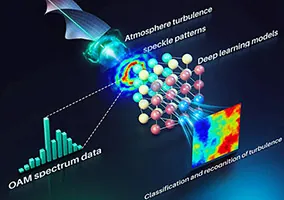
The Future of Optical Metrology: Exploring the Power of Orbital Angular Momentum
2025-01-10
Author: Li
Introduction
Metrology, the essential science of measurement, remains a cornerstone of modern industry, setting the benchmarks that govern how we quantify the world around us. Optical metrology, a branch of this field, has traditionally relied on the principle of interference—a concept that has stood the test of time since Thomas Young’s groundbreaking experiments more than two centuries ago. However, researchers are now exploring exciting new dimensions of measurement through the concept of orbital angular momentum (OAM).
Recent Study Findings
A recent study featured in the journal Light: Science & Applications reveals the promising potential of OAM in optical metrology. Led by Prof. Lixin Guo from Xidian University, the paper dives deep into the principles, advancements, and innovative applications that OAM offers. One of the most thrilling applications discussed is the ability of twisted light—light that carries OAM—to revolutionize how we track three-dimensional particle positions. This advancement opens new avenues for analyzing frequency shifts that are intricately linked to OAM and polarization, offering a contemporary twist on the classic Doppler effect.
Transformative Potential
"The original Doppler effect was limited to tracking movement directly towards or away from the observer," explains Prof. Andrew Forbes, a corresponding author on the study, illuminating its transformative potential. "With the incorporation of orbital angular momentum in both scalar and vector light, we can now track motion in any direction, including rotational movements. This has fundamentally changed the landscape of dynamic systems metrology."
OAM Spectrum as a Fingerprint
Another noteworthy development stemming from this research is the creation of unique instruments centered around the OAM spectrum, which may serve as a 'fingerprint' for complex systems. When OAM light traverses through various media, it not only alters its OAM but also reshapes its spectral profile. This OAM fingerprint could capture a wealth of data that scientists might utilize for groundbreaking applications.
Integration with Machine Learning
As Dr. Mingjian Cheng, the lead author of the paper, points out, "The OAM fingerprint of a medium is packed with valuable information that we can potentially leverage." By integrating OAM spectrum data with machine learning and artificial intelligence, researchers anticipate real-time analysis and recognition of sophisticated media using OAM light as a probing tool; a rapidly evolving area ripe for exploration.
Quantum Metrology Opportunities
Furthermore, the exploration of metrology with classical light paves the way for investigating OAM's vast potential in quantum systems. The potential for OAM to facilitate quantum-entangled superpositions and optimize measurement accuracy with fewer samples opens doors to an exciting frontier in measurement science. Although still in its early days, quantum metrology incorporating OAM presents numerous underexplored opportunities.
Conclusion
"The field of quantum metrology using OAM is still in its infancy, but the possibilities are virtually limitless," adds Prof. Forbes, emphasizing the vast potential that lies ahead.
As we edge closer to integrating OAM into practical metrology applications, the advancements are likely to redefine our understanding of measurement, with implications that could resonate across various industries, from telecommunications to materials science, and beyond. Keep an eye on this burgeoning field, as it may just be the key to unlocking a new era in measurement science!



 Brasil (PT)
Brasil (PT)
 Canada (EN)
Canada (EN)
 Chile (ES)
Chile (ES)
 Česko (CS)
Česko (CS)
 대한민국 (KO)
대한민국 (KO)
 España (ES)
España (ES)
 France (FR)
France (FR)
 Hong Kong (EN)
Hong Kong (EN)
 Italia (IT)
Italia (IT)
 日本 (JA)
日本 (JA)
 Magyarország (HU)
Magyarország (HU)
 Norge (NO)
Norge (NO)
 Polska (PL)
Polska (PL)
 Schweiz (DE)
Schweiz (DE)
 Singapore (EN)
Singapore (EN)
 Sverige (SV)
Sverige (SV)
 Suomi (FI)
Suomi (FI)
 Türkiye (TR)
Türkiye (TR)
 الإمارات العربية المتحدة (AR)
الإمارات العربية المتحدة (AR)